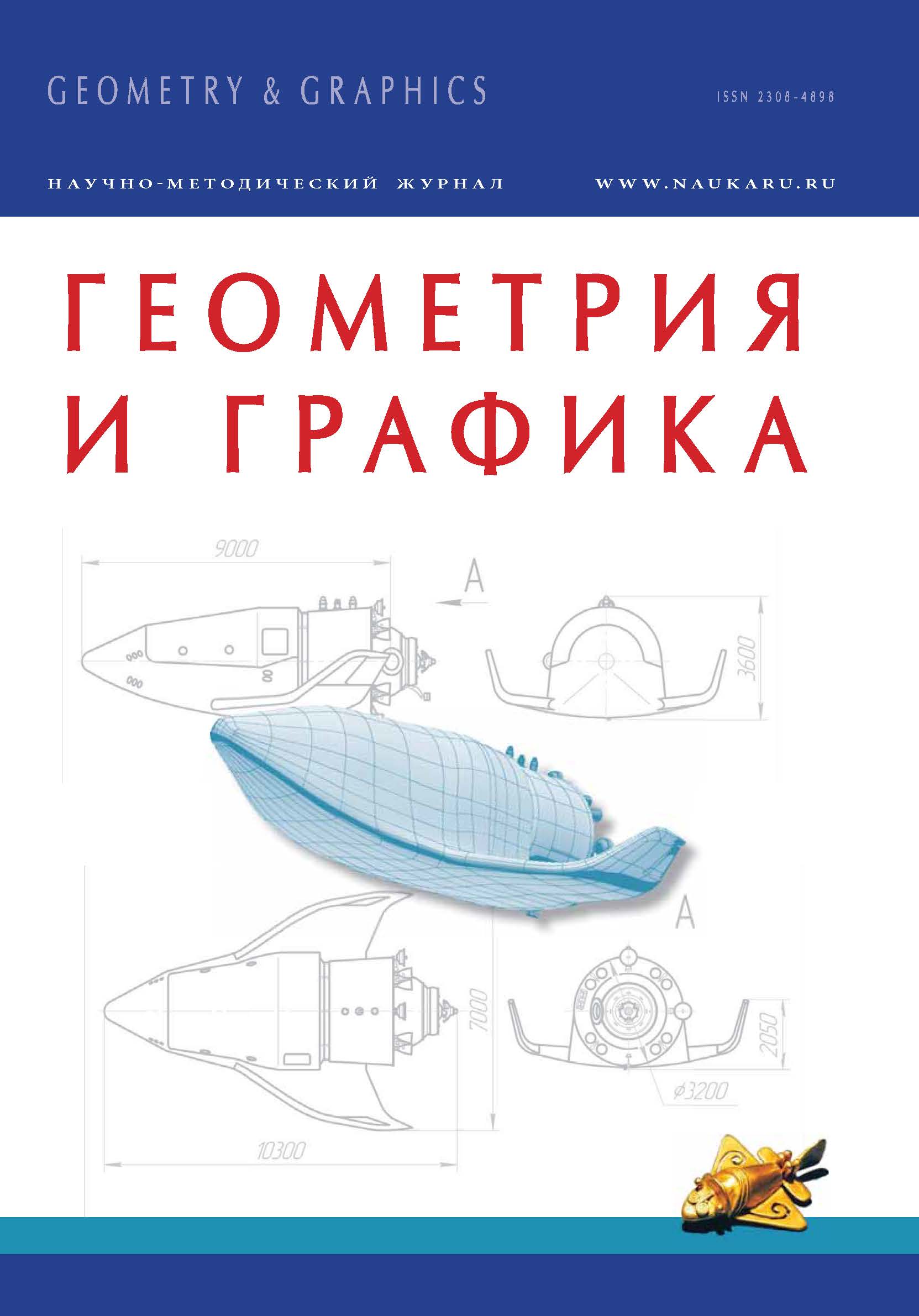Chelyabinsk, Chelyabinsk, Russian Federation
In this paper are considered historically the first (the 60’s of the 20th century) computational methods for algebraic cubic curves constructing. The analysis of a general cubic curve equation r(t)=a3t3+a2t2+a1t+a0 has been carried out. As an example has been considered the simplest cubic curve r(t)=it3+jt2+kt. Based on the general cubic curve equation have been obtained equations of a cubic curve passing through two predetermined points and having predetermined tangents at these points. The equations have been presented both in Ferguson and Bézier forms. It has been shown that the cubic curve vector equation (for example, the standard equation of a Bezier curve) can be represented in a point form. Have been considered examples for constructing segments of cubic curves meeting the given boundary conditions. The generalized cubic curve equation, containing weight coefficients, has been obtained by the method of exit into four-dimensional space. Has been considered a vector parametric equation of a conical section, passing through two given points and touching predetermined straight lines at these points. The conical section is considered as a special case of a cubic curve. Curvature can be specified as an additional boundary condition. Has been considered the possibility for constructing a cubic curve with fixed positions of contacting planes at end points and given radii of curvature. Has been proposed an algorithm for constructing a plane cubic curve with a given curvature at the end points. Have been considered algorithms for constructing smooth compound Ferguson-Bezier curves. Smoothness conditions are imposed on a compound curve: 1) at any of its points, the curve must have a tangent (no fractures are allowed), 2) the curvature vector must be changed continuously from point to point (no discontinuous jump in the curvature vector is allowed neither in modulus no in direction). Have been proposed examples for constructing compound Ferguson-Bézier curves. Has been performed comparison of polynomial cubic spline with compound parametrically defined curves. Have been given examples for constructing cubic splines with fastened and free ends. The paper is for educational purposes, and intended for in-depth study of computer graphics basics.
Ferguson curve, Bezier curve, compound curve, smoothness, curvature, cubic spline
1. Bojkov A.A. O postroenii modelej ob"ektov prostranstva chetyrekh i bolee izmerenij v ucheb-nom processe [About building models of objects in space of four or more dimensions in the educational process]. Geometriya i grafika [Geometry and graphics]. 2018, V. 6, I. 4, pp. 54-72. DOIhttps://doi.org/10.12737/article_5c21f96dce5de8.36096061. (in Russian)
2. Borisenko V.V. Postroenie optimal'nogo splajna Bez'e [Constructing an optimal Bezier spline]. Fundamental'naya i prikladnaya matematika [Fundamental and Applied Mathematics]. 2016, V. 21, I. 3, pp. 57-72. (in Russian)
3. Bronshtejn I.N., Semendyaev K.A. Spravochnik po matematike [Mathematics reference]. Moscow, Nauka Publ., 1986. 544 p. (in Russian)
4. Golovanov N.N. Geometricheskoe modelirovanie [Geometrical Modeling]. Moscow, Publishing House of Physical and Mathematical Literature, 2012. 472 p. (in Russian)
5. Gotovcev A.A. Autodesk alias: s chego nachat' [Autodesk alias: where to begin]? CADMASTER [GADMASTER]. 2012, I. 5 (66), pp. 42-44. (in Russian)
6. Zav'yalov YU.S., Leus V.A, Skorospelov V.A. Splajny v inzhenernoj geometrii [Splines in engineering geometry], Moscow, Mashinostroenie Publ., 1985, 224 p. (in Russian)
7. Konopackij E.V., Krys'ko A.A, Bumaga A.I. Vychislitel'nye algoritmy modelirovaniya odnomernyh obvodov cherez k nape-red zadannyh tochek [Computational algorithms for modeling one-dimensional contours through k predetermined points]. Geometriya i grafika [Geometry and graphics]. 2018, V. 6, I. 3, pp. 20-32 DOI:https://doi.org/10.12737/article_5bc457ece18491.72807735. (in Russian)
8. Lyubchinov E.V., Panchuk K.L. O gladkosti stykovki linij i poverhnostej pri ciklograficheskom modelirova-nii poverhnostnyh form avtomobil'nyh dorog [On the smoothness of joining lines and surfaces in cyclographic modeling of surface forms of highways]. Vestnik YUUrGU. Seriya “Stroitel'stvo i arhitektura” [Bulletin of SUSU. Series "Building and architecture"]. 2020, V. 20, I. 1, pp. 52-62. DOI:https://doi.org/10.14529/build200106. (in Russian)
9. Mufteev V.G. Modelirovanie krivyh vysokogo kachestva [High quality curve modeling]. Elektronnyj zhurnal «Prikladnaya geometriya» [Electronic journal "Applied Geometry"]. 2007, V. 9, I. 19, pp. 25-74. Available at. mai.ru/~ap. (in Russian)
10. Nazarova O.N. Sovremennye problemy prepodavaniya kursa “Prikladnaya geometriya i inzhener-naya grafika” dlya ekspluatacionnyh napravlenij aviacionnogo vuza [Modern problems of teaching the course "Applied Geometry and Engineering Graphics" for the operational directions of an aviation university]. Geometriya i grafika [Geometry and graphics]. 2020, V. 8, I. 2, pp. 58-65. DOI:https://doi.org/10.12737/2308-4898-2020-58-65. (in Russian)
11. Pontryagin L.S. Kubicheskaya parabola [Cubic parabola]. Nauchno-populyarnyj fiziko-matematicheskij zhurnal «Kvant» [Popular scientific physics and mathematics journal "Kvant"], 1984. I. 3, pp. 10-14, 32. (in Russian)
12. Preparata F., SHejmos M. Vychislitel'naya geometriya [Computational geometry]. Moscow, Mir Publ., 1989. 478 p. (in Russian)
13. Savel'ev YU.A., CHerkasova E.YU. Vychislitel'naya grafika v reshenii netradicionnyh inzhenernyh zadach [Computational graphics in solving unconventional engineering problems]. Geometriya i grafika [Geometry and graphics]. 2020, V. 8, I. 1, pp. 33-44. DOI:https://doi.org/10.12737/2308-4898-2020-33-44. (in Russian)
14. Sal'kov N.A. Geometricheskaya sostavlyayushchaya tekhnicheskih innovacij [The geometric component of technical innovation]. Geometriya i grafika [Geometry and graphics]. 2018, V. 6, I. 2, pp. 85-93 DOIhttps://doi.org/10.12737/article_5b55a5163fa053.07622109. (in Russian)
15. Suhih B. I., Vajsburd R.A. Vychislitel'naya geometriya. Osnovnye ob"ekty i preobrazovaniya [Computational geometry. Basic objects and transformations]. Ekaterinburg, izd-vo UPI Publ., 1989, 92 p. (in Russian)
16. Usataya T. V., Deryabina L.V., Reshetnikova E.S. Sovremennye podhody k proektirovaniyu izdelij v processe obucheniya studentov komp'yuternoj grafike [Modern approaches to product design in the process of teaching students computer graphics]. Geometriya i grafika [Geometry and graphics]. 2019, V. 7, I. 1, pp. 74-82. DOI:https://doi.org/10.12737/article_5c91fd2bde0ff7.07282102. (in Russian)
17. Fedoseeva M.A. Metodika podgotovki studentov tekhnicheskih vuzov graficheskim disciplinam [Methods of training students of technical universities in graphic disciplines]. Geometriya i grafika [Geometry and graphics]. 2019, V. 7, I. 1, pp. 68-73. DOI:https://doi.org/10.12737/article_5c91fed8650bb7.79232969. (in Russian)
18. Finikov S.P. Kurs differencial'noj geometrii [Differential Geometry Course], Moscow, URSS Publ., 2006, 344 p. (in Russian)
19. Foks A., Pratt M. Vychislitel'naja geometrija. Primenenie v proektirovanii i na proizvodstve [Computing Geometry. Application in Design and on Production], Moscow, Mir Publ., 1982, 304 p. (in Russian)
20. Shikin E.V., Pliss L.I. Krivye i poverkhnosti na ekrane komp'yutera [Curves and Surfaces for Computer Screen], Moscow, Dialog-MIFI Publ., 1996, 240 p. (in Russian)






